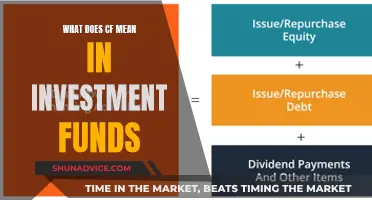
Large-cap funds are a type of investment fund that focuses on investing in the stocks of large companies, typically those with a market capitalization of over $10 billion. These funds offer investors exposure to some of the biggest and most well-known companies in the world, such as Amazon, Coca-Cola, and General Motors. Large-cap funds are often considered a safer investment option compared to small-cap or mid-cap funds as they tend to be less volatile and more stable. They are also more diversified, both in terms of their business operations and their global footprint, which helps to reduce the risk of failure. While large-cap funds may not offer the same high growth potential as smaller companies, they can still provide attractive returns over the long term.
| Characteristics | Values |
|---|---|
| Market Capitalization | More than $10 billion |
| Risk | Less risky than small- and mid-cap stocks |
| Returns | Lower returns than small- and mid-cap stocks |
| Volatility | Less volatile than small-cap stocks |
| Dividends | Often pay dividends |
| Growth | Lower growth potential than small- and mid-cap stocks |
| Transparency | Easy to find and analyze public information |
| Benchmark Indexes | S&P 500, Dow Jones Industrial Average, Nasdaq Composite |
What You'll Learn
- Large-cap funds are a good starting point for new investors
- Large-cap funds are less volatile and offer more stability
- Large-cap funds are ideal for risk-averse investors
- Large-cap funds are suitable for long-term investment horizons
- Large-cap funds are a good option for investors seeking stable returns

Large-cap funds are a good starting point for new investors
Large-cap funds are a good option for those seeking a safer, more conservative investment choice. They are typically less risky compared to small- or mid-cap stocks, as large-cap companies are more established, with competitive advantages and more reliable profit streams. This means they tend to be less vulnerable to market fluctuations and economic downturns. Large-cap stocks have outperformed their smaller peers over the past decade, and they did so with less volatility—for example, the S&P 500 dropped less than the Russell 2000 during the COVID-19 pandemic in March 2020.
Large-cap funds are a good option for investors seeking long-term growth solutions. They are also a good choice for those who want stocks with relatively low volatility. If your portfolio is currently dominated by volatile growth stocks, adding some large-cap funds can be a smart way to diversify your holdings without sacrificing too much growth potential.
There are a variety of large-cap funds to choose from, including exchange-traded funds (ETFs) and mutual funds. ETFs are a good option for new investors as they are easy to invest in and offer exposure to a group of stocks rather than picking individual stocks. Some examples of large-cap ETFs include the Vanguard S&P 500 ETF and the Fidelity Contrafund.
Index Funds: Investing Basics for Beginners
You may want to see also

Large-cap funds are less volatile and offer more stability
Large-cap companies have a market capitalization of over $10 billion and are usually found in the market's leading benchmark indexes, such as the S&P 500, the Dow Jones Industrial Average, and the Nasdaq Composite. These companies are often transparent, making it easy for investors to find and analyze public information about them. They are also more stable and less prone to wild swings in stock prices, which makes them a more conservative investment choice.
Large-cap funds are ideal for investors seeking stable returns with relatively lower risk. These funds are suitable for those with a low-risk appetite and a long-term investment horizon. Large-cap companies are leaders in their fields and have a consistent track record of high profits over extended periods. They have steady revenue generation and sound business plans, making them a stable investment option.
Additionally, large-cap companies often pay dividends, providing a steady income stream for investors, especially those seeking passive income. The stock prices of these companies do not fluctuate significantly, offering better capital appreciation to investors. They can also endure market turbulence and recessions due to their financial stability and diverse business operations.
Overall, large-cap funds are a good option for investors who want to benefit from the stability and lower volatility they offer while still achieving moderate growth.
China Funds: Invest or Avoid?
You may want to see also

Large-cap funds are ideal for risk-averse investors
Large-cap funds primarily invest in blue-chip companies, which are dominant leaders in their respective industries. These companies have a market capitalisation of over $10 billion, with some sources citing a minimum of $20 billion. They are typically well-known, mature businesses with stable management teams, strong credit ratings and a history of profits. Examples include Disney, Coca-Cola, General Motors, Amazon and JPMorgan Chase.
By investing in these large, established companies, large-cap funds offer a more stable option for investors. These companies have a proven track record of success and are better equipped to withstand market fluctuations and economic downturns. Their size and financial stability reduce the likelihood of insolvency or a forced halt in operations. This stability lends a degree of resilience to investment portfolios, making large-cap funds particularly appealing to risk-averse investors.
Large-cap funds also provide the advantage of steady dividend payouts. As these companies are already well-established, their stock prices may not exhibit high growth rates. To compensate shareholders, large-cap companies often distribute dividends. This makes large-cap funds attractive to income investors or those seeking conservative investment strategies.
Additionally, large-cap funds offer greater transparency and ease of analysis. The long business tenure of these companies allows investors to access extensive research and financial statements, facilitating informed investment decisions. The Russell 1000 Index is a valuable resource for identifying and evaluating large-cap companies.
While large-cap funds offer stability and lower risk, it's important to remember that all investments carry some degree of risk. Large-cap funds may have lower growth potential compared to mid-cap and small-cap funds, and their returns may lag during bull markets. Therefore, it is essential for investors to carefully consider their risk tolerance, investment goals and time horizon before making any investment decisions.
Tax Managed Mutual Funds: When to Invest for Maximum Benefits
You may want to see also

Large-cap funds are suitable for long-term investment horizons
Large-cap funds are a good starting point for new investors, offering lower risk while generating higher returns. These funds are ideal for risk-averse investors or those who do not want their returns to fluctuate significantly. Large-cap funds are also suitable for investors with a long-term investment window, such as those planning for retirement. The recommended minimum investment period for large-cap funds is 3 to 5 years, and they are best suited for those with surplus cash.
Large-cap funds offer steady returns, good capital appreciation over time, and regular dividends. They invest in top-tier companies that are leaders in their fields, with strong reputations and consistent records of high profits. These companies have stable growth and are not severely affected by market changes, providing stability to investment portfolios. Large-cap funds are also known for their good liquidity, which helps manage investments without significant losses during adverse market conditions.
Large-cap companies are typically well-known, established businesses with transparent operations. This makes it easy for investors to find and analyse information about the fund and its underlying investments. The mature market establishment of many large-cap companies has allowed them to institute and commit to high dividend payout ratios.
Large-cap funds are considered less risky than small- and mid-cap funds. They are built to handle the stock market's volatility and are suitable for investors seeking stable returns with relatively lower risk. Large-cap companies are more established, dominant in their industries, and have competitive advantages and reliable profit streams. As a result, large-cap stocks tend to outperform small-caps during a bear market.
Market Volatility: Is Now the Time to Invest?
You may want to see also

Large-cap funds are a good option for investors seeking stable returns
Large-cap funds invest in stocks of these larger companies, which have a market capitalization of more than $10 billion. These companies are leaders in their fields, with solid reputations, stable management teams, and a consistent track record of high profits. They tend to be less volatile and offer more stability compared to small-cap stocks, making them a safer investment option. Large-cap stocks also often pay dividends, providing a steady income stream for investors, especially those seeking passive income or regular dividends.
Large-cap funds are ideal for investors who want to balance risk and return. These funds offer investment stability, better capital growth, sound investment decisions, high liquidity, and the ability to withstand recessions due to their diversification across sectors. They are also less prone to wild swings in stock prices and are considered more conservative investments. Additionally, large-cap companies have transparent operations, making it easy for investors to find and analyze public information about them.
While large-cap funds may not offer the same high growth potential as small- or mid-cap funds, they are still profitable opportunities for investors. They can be a good starting point for those new to the arena of investments, as they provide lower risk and the potential for higher returns. Large-cap funds are also ideal for long-term investment horizons, with recommendations to invest for at least 5-7 years.
Target Date Funds: Charles Schwab Investment Strategies
You may want to see also
Frequently asked questions
Large-cap funds are equity funds that invest in large, well-established companies with a market capitalization of over $10 billion. These companies are often household names and are leaders in their respective industries.
Large-cap funds offer stability, lower volatility, and steady returns. They are ideal for risk-averse investors as they are less prone to wild swings in stock prices and can weather economic downturns better. Large-cap companies also tend to pay reliable dividends, providing a steady income stream for investors.
Large-cap funds may offer lower growth potential compared to small- or mid-cap funds. They may also be more sensitive to economic changes and can underperform during certain market conditions. Additionally, actively managed large-cap funds may come with higher fees.
Large-cap funds are suitable for investors seeking stable returns with relatively lower risk. They are ideal for those with a long-term investment horizon, such as retirement planning. Large-cap funds can also help diversify a portfolio of smaller stocks while providing good share price growth over time.
You can invest in large-cap funds by purchasing individual stocks of large-cap companies, investing in an exchange-traded fund (ETF) that tracks a large-cap benchmark, or through mutual funds focused on large-cap investments. It is important to conduct thorough research and consider factors such as investment risks, expense ratios, and investment horizons before investing.







